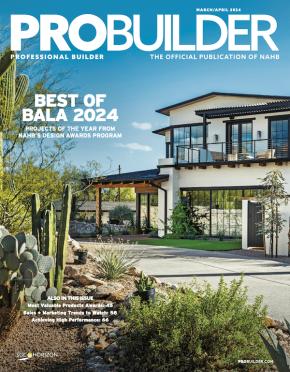| Land planner Rick Harrison makes the case that his new "bay home" concept, on display at a 26-home neighborhood in Hutchinson, Minn., improves upon new urbansim by offering views of open space and an increased sense of privacy.
|
Credit the grid patterned streets and alleyways of the New Urbanism movement for tapping a deep mine of nostalgia that Americans feel for neighborhoods built in the early 1900s. The unqualified success of pedestrian-oriented master plans like The Kentlands outside Washington, D.C., and Seaside, Fla., proves the point. But land planner Rick Harrison wonders whether some shortcomings of strict new urbanism—namely a lack of views and a decreased perception of privacy—might be remedied with a different take on the trend.
Minneapolis-based Harrison is perhaps best known for pioneering covering, a planning concept that uses narrow streets in cove-like patterns to increase units per acre without sacrificing lot sizes. Lately, at a 10-acre neighborhood in rural Hutchinson, Minn., Harrison has been showcasing a land plan that he says offers a better balance of privacy and views, along with a close-knit community feeling.
"We don’t claim that this is going to change society," says Harrison referring to the lofty goals of New Urbanists. "But what it will do is bring people out. People want inviting open space."
The Bay Home
Elements of coving are included in the new community and from the standpoint of minimizing paved areas, it goes much further. The 26 detached condominiums being built at The Greens by local builder/developer Tom Palmby, each front along open space and walkways. Cars, meanwhile, approach rear garages on 24-foot wide private lanes.
But the concept most on display, is Harrison’s unique solution for orienting homes to one another so as to maximize views of landscaping and ponds without altering the narrow, 10-foot sideyards. Each of the footprints are angled and staggered lot by lot with varying setbacks. As a result, the homes, which range in size from 1300 to 2200 square feet, are close to one another, but they don’t feel close.
This "bay home" arrangement, as Harrison calls it, allows for both a front view and a side view out onto a new urban style front porch as well as the open space and walkway beyond it. He points out that homes built on grid patterned streets with alleys tend to offer only one view, out the front of the home, which is usually a street.
The bay home concept also makes it easier to minimize privacy issues. Because the overlap between houses is less than if they had been laid out perpendicularly, architects can comfortably specify fewer windows on walls facing the sideyards of neighboring homes without giving up too much natural light.
"The views are great," a woman touring the models told Harrison. "But what happens when they build the house next door?" Needless to say, he was glad to point out that the house next door was already built.







